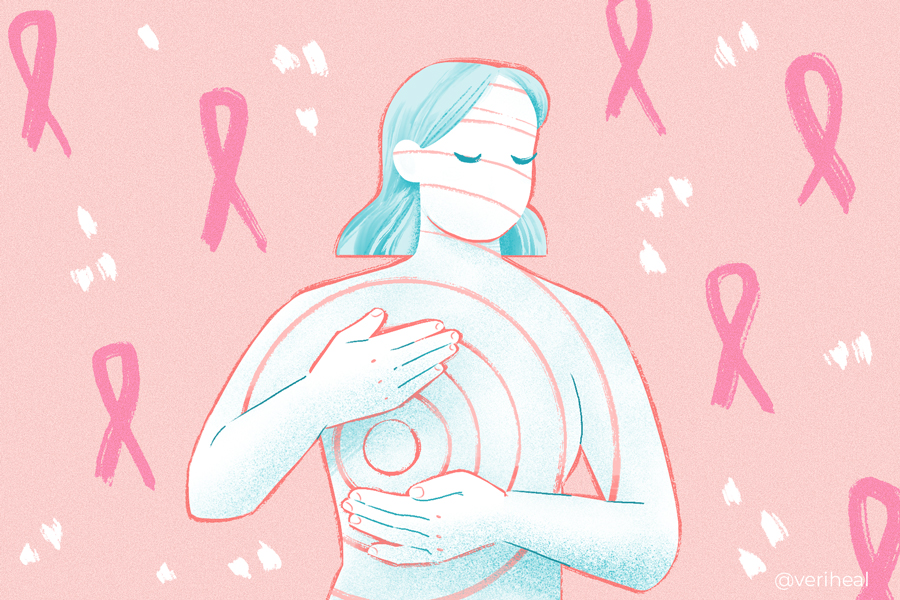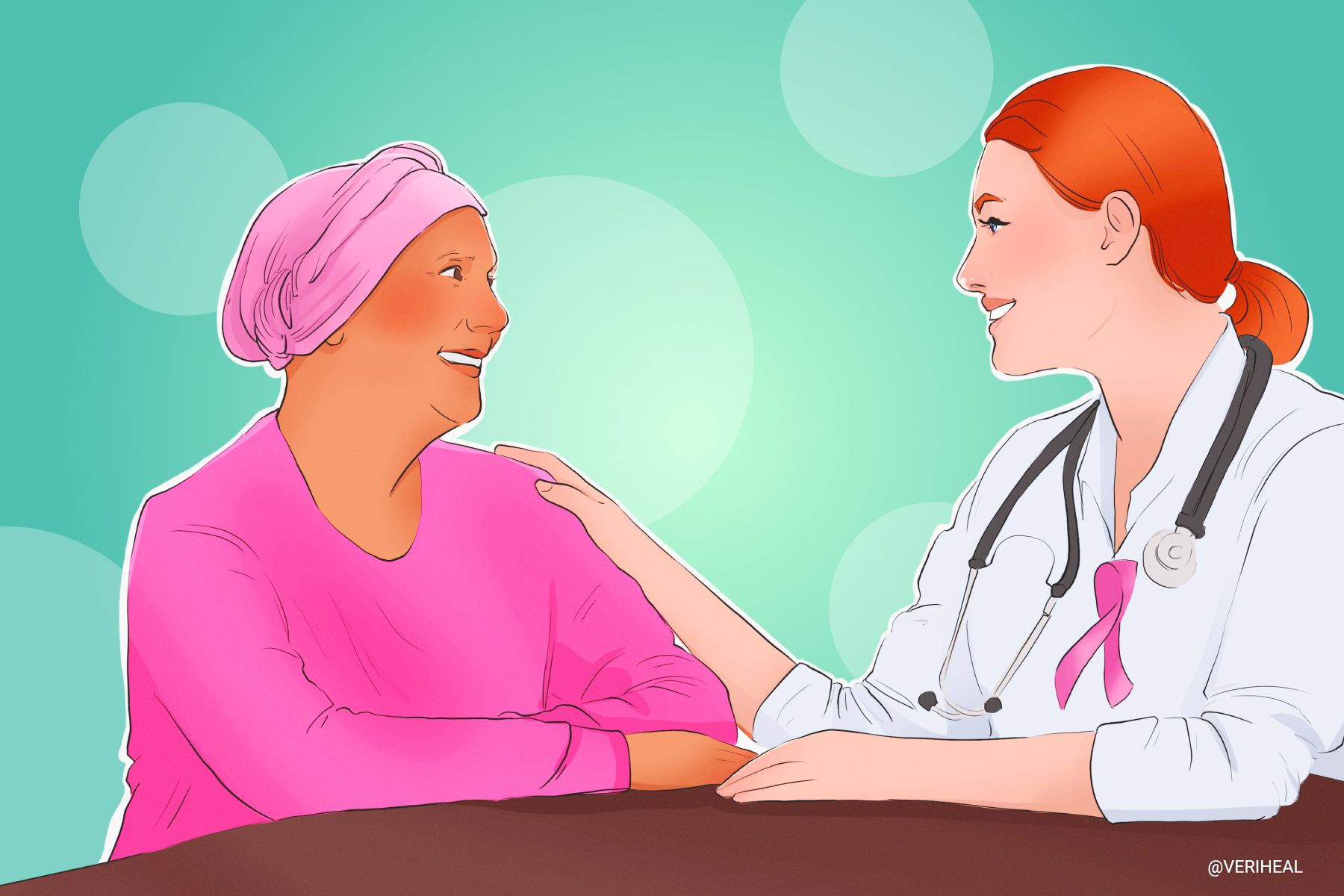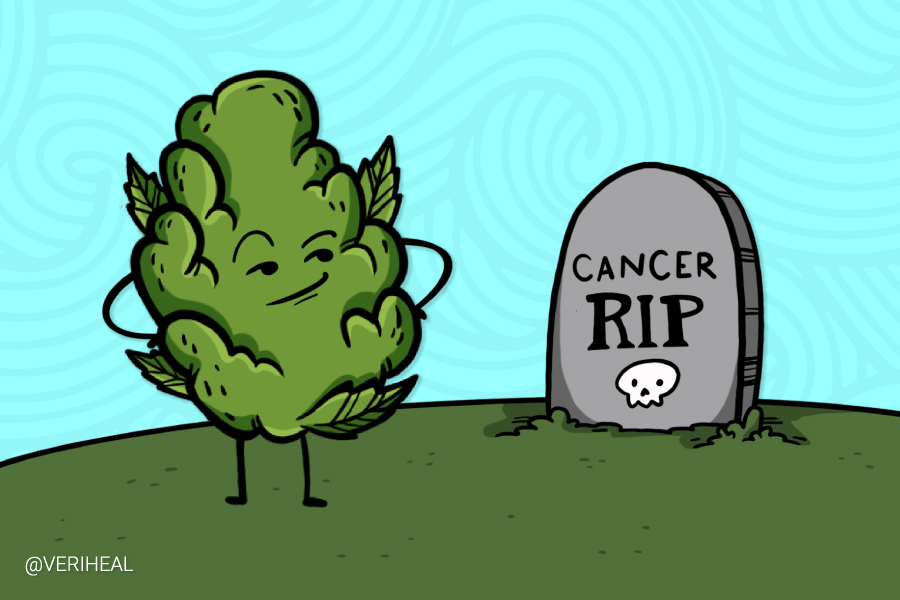Are Patients Using Marijuana for Breast Cancer Symptoms?
- Treating Breast Cancer with Medical Cannabis
- Cannabis and Her2-Positive Breast Cancer
- Medical Marijuana & Hormone-Sensitive Breast Cancer
- Cannabis-derived Prescriptions for Cancer Patients
- Different Treatment Recommendations for Breast Cancer Patients
- Oncologists’ Thoughts on Medical Cannabis
- What is Breast Cancer?
- What are the Symptoms of Breast Cancer
- Understanding the Different Types of Breast Cancer
- Breast Cancer Hormone Receptor Status
- What Her2 Breast Cancer Status Means
- Early Detection
Cannabis has long been known for its ability to help relieve chronic pain, poor appetite, nausea, and vomiting for cancer patients. The health benefits of using medical marijuana begin in the endocannabinoid system (8). The endocannabinoid system consists of fat-based neurotransmitters that are made in the body. These neurotransmitter levels play a role in inflammation, hormones, and the immune system.
Cannabis contains hundreds of cannabinoids, including Δ9-tetrahydrocannabinol (THC) and cannabinol (CBD), which can influence the self-made endocannabinoids through the cannabinoid receptors CB1 and CB2. CB1 receptors are found primarily in the central nervous system, while CB2 receptors are found in joints, immune cells, intestinal tissues, and other organs.
For more information on how the endocannabinoid system works, please see our page on endocannabinoids here.
Treating Breast Cancer with Medical Cannabis
Current research shows that the cannabis plant has the potential to produce antitumor responses, but most of these studies use THC isolates, while most patients who use it to treat their cancer utilize the whole plant and the other phytocannabinoids found in it (1).
Smoking or vaporizing cannabis may not be the safest choice for patients who are receiving certain cancer therapies or with underlying lung issues (23). For example, it may be helpful for taking medical marijuana for nausea, but it may interfere with the effectiveness of certain types of chemotherapy. It can also increase the risk of lung damage while you are undergoing chemo or radiation if it is smoked or vaped.
It is important to talk to the doctor who is treating your cancer about potentially using cannabinoids as part of your breast cancer treatment as they may interfere with certain types of treatments. Regular screenings and follow-up care with your provider are very important and cannot be substituted by medical cannabis, but possibly supplemented with it. Your doctor also might be able to connect you to other patients who are using to help their treatment (23).
Below we will look at a few clinical trials examining the antitumor effects of medical marijuana when it comes to treating specific types of breast cancer. Please continue reading further below in this article for specific information about cancer with hormone receptors and the HER2 protein. Both components make this type of cancer more difficult to treat.
Cannabis & HER2-Positive Breast Cancer
The 2019 study “Therapeutic targeting of HER2–CB2R heteromers in HER2-positive breast cancer“ shows us that the HER2 protein specifically interacts with CB2 receptors. When THC is introduced to the CB2 receptors, it inactivates the HER2 protein binders and degrades them through the E3 ligase c-CBL (4). This study evaluated HER2-positive biopsies of patients with ductal cancer of the breast.
Medical Marijuana & Hormone-Sensitive Breast Cancer
A study published in 2018 found that when looking at hormone-sensitive breast cancer, a botanical drug preparation (BDP) was actually more effective at causing cancer cell death than THC on its own (this also includes triple-positive cancer) (3). The BDP was a combination of cannabis terpenes plus either an estrogen receptor drug (tamoxifen), HER2 treatment drug (lapatinib), or Cisplatin, a rapid cell-killing drug. Results show us that further research is needed into how the entourage effect can more effectively target tumor growth. In this study, the BDP produced responses within breast cancer cells that slowed proliferation.
Check out our page on the entourage effect to learn more.
Cannabis-derived Prescriptions for Cancer Patients
The following are prescription medications that have been tested on patients with cancer. It is important to note that not all of these prescriptions are available in the United States, but they are important tools for researchers to understand how patients may benefit from medical marijuana. Many of these medications contain synthetic cannabinoids. These medications include (2):
Dronabinol/Marinol
- For chemotherapy-induced nausea and cancer-related nausea.
- Contains synthetic THC.
- Taken orally by capsule.
- Shown to be as effective as traditional anti-nausea medications in terms of complete control of nausea and vomiting.
Nabilone/Cesamet
- For chemotherapy-related nausea and cancer-related nausea.
- Synthetic THC.
- Taken orally by capsule.
- Shown to be as effective as traditional anti-nausea medications for controlling nausea and vomiting.
Nabiximols/Sativex
- Increases appetite in cancer patients and treats cancer-related nausea.
- 1:1 CBD to THC ratio extracted by ethanol (7).
- An oral spray that absorbs through the cheeks in the mouth.
- Insufficient evidence for controlling nausea.
- Since the 2017 review from Australia cited above, Nabiximols appears to have some benefit for chronic-cancer-related pain and improved sleep. The sample studies linked to this data are currently small and more research is needed on the improvements in pain scale rating on a wider scale (29).
- Approved by Health Canada for cancer-related pain in patients who have maximized opioid therapy and are still experiencing moderate to severe pain. However, it has not been approved by the FDA despite ongoing research trials (7).
- As of 2021, Sativex is the only marijuana-based medication available for use during cancer treatments in the United States.
Levonantradol
- Only used in research as it is an experimental analog of Dronabinol. It is not available as a prescription.
- Insufficient evidence to treat chemotherapy-induced nausea.
- Injected into muscles.
- Insufficient evidence for controlling nausea and vomiting.
- Insufficient evidence overall for effective use (27).
Different Treatment Recommendations for Breast Cancer Patients
In general, it is recommended to start with lower cannabis doses and then to gradually taper doses up when it comes to treating cancer (23). There are several different cannabis products available, including tinctures and vaping products. What is available at your dispensary will depend on your state’s medical marijuana program.
Check out our page on nausea for information on treating cancer-related nausea or chemotherapy-induced nausea.
Oncologists’ Thoughts on Medical Cannabis
A 2016 survey was sent out to 400 oncologists to gather information about their thoughts on prescribing marijuana for cancer. 237 oncologists responded, with 80% of the physicians stating that they have had conversations about medical marijuana with patients and 43% recommended its clinical use (5). Many of these physicians (67%) responded that they believed cannabis is helpful in adjunct to standard pain and 65% percent thought it was either just as effective or more effective than standard treatments for anorexia and cachexia, a form of extreme weight loss when the body is very ill.
The study showed that oncologists encounter conversations about medical marijuana fairly regularly, but that 70% of them do not feel equipped to make recommendations for clinical use (5). Unfortunately many large medical institutions still ban doctors from prescribing medical cannabis, though they have an interest in it for their patients.
What is Breast Cancer?
The Centers for Disease Control and Prevention (CDC) defines breast cancer as “a disease in which cells in the breast grow out of control (31).” There are different varieties of this type of cancer that get diagnosed depending on which cells in the breast have turned cancerous. The breast is made up of three main parts called the lobules (the glands in the breast which produce milk), ducts (are the tubes that carry milk to the nipple), and connective tissue which consists of fibrous and fatty tissue which holds everything together.
Most breast cancers begin in the ducts or the lobules and that cancer can spread beyond the breast through blood and lymph vessels (31). When cancer spreads from the breast to other parts of the body, it is referred to as having metastasized.
What Are the Symptoms of Breast Cancer?
While it is good to understand the symptoms of having breast cancer, one should immediately contact their physician but should not panic because the symptoms are shared by other conditions. It is also important to remember that just as we are all different, so will our experience be with breast cancer symptoms, which are as follows (32):
- Lump(s) in the breast(s) or armpit(s)
- Swelling of the breast(s) or parts thereof
- Irritated breast skin
- Dimpling of breast skin
- Redness of skin or nipple area
- Flaky skin in the nipple or the breast
- Pain in the nipple area
- The sinking of the nipple
- Nipple discharge other than breast milk
- Changes in the shape and size of the breast
- Pain in any area of the breast
If you have any of these symptoms which cause you to worry, see your physician as soon as possible. It may turn out to be nothing or benign, which will put your mind at ease. If it turns out you may have cancerous cells, hopefully, it has been caught soon enough to treat.
Understanding the Different Types of Breast Cancer
There are several different types of breast cancer. These types can be differentiated by what part of the breast they begin in as well as how severe the cancer is.
Ductal Carcinoma in Situ (DCIS) (9)
- Cancer starts inside the milk ducts.
- Non-invasive cancer that doesn’t spread into other tissues, but increases the chances of developing invasive cancer in the future.
Invasive Ductal Carcinoma (IDC)
- The most common type of breast cancer (17).
- Begins in the milk ducts (17).
- Can spread to other breast tissues (17).
- Subtypes include:
- Tubular carcinoma of the breast
- Consists of tubular-shaped tumors that are typically 1 cm or less (15).
- Medullary carcinoma of the breast (13)
- Consists of a cancerous tumor that is a soft, fleshy mass.
- Named for its resemblance to the part of the brain called the medulla.
- Mucinous carcinoma of the breast
- A cancerous tumor that is made up of abnormal cells that float in pools of mucin, a key ingredient of mucus (4).
- Papillary carcinoma of the breast (12)
- The tumor has a well-defined border and is made up of small, finger-like projections.
- A rare form of IDC.
- Most often diagnosed in women who have been through menopause.
- Can be diagnosed grade 1-3.
- Cribriform carcinoma of the breast (11)
- Cancer cells invade the connective tissues of the breast called the stoma in nest-like formations between the ducts and lobules.
- The tumor has distinctive holes in between the cancer cells.
- Tubular carcinoma of the breast
Invasive Lobular Carcinoma (ILC) (18)
- Also called infiltrating lobular carcinoma.
- The second most common type of breast cancer.
- Cancer begins in the milk-producing lobules that empty out into the milk ducts.
Inflammatory Breast Cancer (16)
- A rare and aggressive form of breast cancer.
- Starts with reddening and swelling of the breast instead of a distinct lump.
- Symptoms worsen within days or hours.
Lobular Carcinoma in Situ (LCIS) (21)
- Area or areas of abnormal cell growth.
- Not breast cancer, but indicates a person has a much higher than average risk for developing it.
- Abnormal cells start growing in the lobules where breast milk is produced.
- In situ means that the tumor doesn’t spread to other tissues.
Male Breast Cancer
- Less than 1% of breast cancers occur in men (22).
Paget’s Disease of the Nipple (25)
- Cancer affects the ducts of the nipple first and then spreads to the areola, or skin on and around the nipple.
- The nipple and areola become scaly, red, itchy, and irritated.
- More than 97% of those with Paget’s disease also have another form of breast cancer.
Phyllodes Tumors of the Breast (26)
- Most tumors are not cancerous, but some can be cancerous or borderline.
- Also called cystosarcoma phyllodes.
- Account for less than 1% of breast cancer tumors.
Metastatic Breast Cancer (24)
- Also called stage 4 breast cancer.
- Breast cancer that has spread or metastasized to another part of the body – most commonly the liver, brain, bones, or lungs.
- 30% of women with early-stage breast cancer will develop metastasis.
Breast Cancer Hormone Receptor Status
Typically, breast cancer cells that are removed during surgery or a biopsy are tested for certain proteins that are estrogen or progesterone receptors (6). This is important to check for because if the cancer cells have these receptors, then estrogen and/or progesterone can bind to the receptors and fuel cancer growth. These protein receptor classifications are also targeted differently than cancers that are negative for these receptors.
It is possible to have one, both, or none of the following receptors (6):
- ER-positive (ER+) – cancers that have estrogen receptors.
- PR-positive (PR+) – cancers that have progesterone receptors.
- Hormone receptor-positive (HR+) – If the cancer cells have one or both of the above receptors, it will be considered HR+.
- Hormone receptor-negative (HR-) – If the cancer cells have neither estrogen or progesterone receptors, then it is HR-.
What HER2 Breast Cancer Status Means
HER2 is a growth-promoting protein that is found on the outside of all breast cells. HER2 basically promotes breast cancer cell growth and increases its ability to spread quickly (6). About one in every five breast cancer patients has excess copies of the gene that makes the HER2 protein (10).
If a patient is diagnosed with invasive breast cancer, it is typically tested for by a biopsy that is tested with immunohistochemical stains (IHC) or fluorescent in situ hybridization (FISH) (6). Cancers that are HER2 positive are treated with medications that specifically target the HER2 protein. Whenever metastasis occurs or spreads, it is recommended that it should be retested for HER2 as well as the hormone receptor status because it can change from the initial cancer diagnosis (10).
The following are possible HER2 statuses (6):
- HER2-negative – the IHC result is 0 or 1+. These cancers do not respond to treatments that target HER2.
- HER2-positive – the IHC result is 3+. This type of cancer responds to treatments targeting HER2.
- Equivocal HER2 status – the IHC result is 2+, so the tumor status isn’t clear and needs to be tested with FISH to clarify the result.
- Triple Negative – breast cancer that doesn’t have too much HER2 and doesn’t impact estrogen and progesterone receptors.
- Triple Positive – Breast cancer tumors that are HER2 positive as well as have estrogen and progesterone receptors. These cancers can be treated with hormone drugs and drugs that target HER2.
Early Detection
It is important to remember that breast cancer can be cured if it is detected early. Here are some steps for self-administered breast examinations in order to locate lumps, bumps, and/or other physical changes that may be indicative of cancer, although most lumps and bumps are diagnosed as benign (not-harmful) (30):
1. Look at your breasts in the mirror. Make sure that your shoulders are straight and that your arms are at your side. Things to look for: (a) unusual size, shape, or/and color as well as (b) uneven shapes without swelling or other visible distortion.
2. Now, still looking in the mirror, raise your arms above your head. Things to look for: (a) unusual size, shape, or/and color as well as (b) uneven shapes without swelling or other visible distortion.
3. Lift one arm to shoulder height and use the opposite hand to the breast (the one that has not been lifted). Use your head to squeeze or compress the nipple. Repeat for the other breast. Things to look for: Unusual discharge from one or both of the nipples such as milky, yellow, or clear fluid and blood)
4. Lay down and use your right hand to feel the left breast and the left hand to feel the right breast. Use a firm and smooth touch to make small circular motions. Make sure to do this for the entire breast, which means from top to bottom (about the length of going from your collarbone to the top of the abdomen) and side to side (about the length of going from the cleavage to the armpit). Things to feel for: Anything that is unusual which feels lumpy, bumpy, and painful.
5. This step can be done in the shower to make it easier to feel. While standing, use the same hand movements as in number 4 to examine the entire breast again. Things to feel for: Anything that is unusual which feels lumpy, bumpy, and painful.
6. Once you have concluded your breast examination and happened to find a lump with or without some of the other symptoms (such as the fluid from nipples), DON’T PANIC! 8 out of 10 women with lumps in their breasts do not have cancerous lumps.
Note: Veriheal does not intend to give this as professional medical advice. Do not attempt to self-diagnose or prescribe treatment based on the information provided on this page. Always consult a physician before making any decision on the treatment of a medical condition.
1. Andia, A. (2019, March 18). Thc vs. breast cancer. Retrieved February 14, 2021, from https://www.projectcbd.org/medicine/thc-vs-breast-cancer
2. Australian Government Department of Health. Therapeutic Goods Administration. (2017, December 21). Guidance for the use of medicinal cannabis for the prevention or management of nausea and vomiting in Australia. Retrieved January 23, 2021, from https://www.tga.gov.au/publication/guidance-use-medicinal-cannabis-prevention-or-management-nausea-and-vomiting-australia
3. Blasco-Benito, S., Seijo-Vila, M., Caro-Villalobos, M., Tundidor, I., Andradas, C., García-Taboada, E., Wade, J., Smith, S., Guzmán, M., Pérez-Gómez, E., Gordon, M., & Sánchez, C. (2018). Appraising the “entourage effect”: Antitumor action of a pure cannabinoid versus a botanical drug preparation in preclinical models of breast cancer. Biochemical pharmacology, 157, 285–293.https://www.sciencedirect.com/science/article/abs/pii/S0006295218302387?via%3Dihub
4. Blasco-Benito, S., Moreno, E., Seijo-Vila, M., Tundidor, I., Andradas, C., Caffarel, M. M., Caro-Villalobos, M., Urigüen, L., Diez-Alarcia, R., Moreno-Bueno, G., Hernández, L., Manso, L., Homar-Ruano, P., McCormick, P. J., Bibic, L., Bernadó-Morales, C., Arribas, J., Canals, M., Casadó, V., Canela, E. I., … Sánchez, C. (2019). Therapeutic targeting of HER2-CB2R heteromers in HER2-positive breast cancer. Proceedings of the National Academy of Sciences of the United States of America, 116(9), 3863–3872. https://www.pnas.org/content/116/9/3863
5. Braun, I. M., Wright, A., Peteet, J., Meyer, F. L., Yuppa, D. P., Bolcic-Jankovic, D., LeBlanc, J., Chang, Y., Yu, L., Nayak, M. M., Tulsky, J. A., Suzuki, J., Nabati, L., & Campbell, E. G. (2018). Medical Oncologists’ Beliefs, Practices, and Knowledge Regarding Marijuana Used Therapeutically: A Nationally Representative Survey Study. Journal of Clinical Oncology, 36(19), 1957–1962. https://ascopubs.org/doi/10.1200/JCO.2017.76.1221
6. Breast cancer her2 status: Her2 positive breast cancer. (n.d.). Retrieved February 14, 2021, from https://www.cancer.org/cancer/breast-cancer/understanding-a-breast-cancer-diagnosis/breast-cancer-her2-status.html
7. Cannabis and Cannabinoids (PDQ®)–Health Professional Version. National Cancer Institute. (n.d.). https://www.cancer.gov/about-cancer/treatment/cam/hp/cannabis-pdq
8. Darkovska-Serafimovska, M., Serafimovska, T., Arsova-Sarafinovska, Z., Stefanoski, S., Keskovski, Z., & Balkanov, T. (2018). Pharmacotherapeutic considerations for use of cannabinoids to relieve pain in patients with malignant diseases. Journal of pain research, 11, 837–842. https://www.ncbi.nlm.nih.gov/pmc/articles/PMC5922297/
9. Ductal carcinoma In Situ: Symptoms, diagnosis, and treatment. (2019, March 09). Retrieved February 14, 2021, from https://www.breastcancer.org/symptoms/types/dcis
10. Giridhar, K. (2020, April 7). What to know about HER2-positive breast cancer. Mayo Clinic. https://www.mayoclinic.org/breast-cancer/expert-answers/faq-20058066
11. IDC type: Cribriform carcinoma of the breast. (2019, March 09). Retrieved February 14, 2021, from https://www.breastcancer.org/symptoms/types/cribriform
12. IDC type: Papillary carcinoma of the breast. (2019, March 09). Retrieved February 14, 2021, from https://www.breastcancer.org/symptoms/types/papillary
13. IDC type: MEDULLARY carcinoma of the breast. (2020, January 21). Retrieved February 14, 2021, from https://www.breastcancer.org/symptoms/types/medullary
14. IDC type: Mucinous carcinoma of the breast. (2020, January 21). Retrieved February 14, 2021, from https://www.breastcancer.org/symptoms/types/mucinous
15. IDC type: TUBULAR carcinoma of the breast. (2020, January 21). Retrieved February 14, 2021, from https://www.breastcancer.org/symptoms/types/tubular
16. Inflammatory breast cancer. (2020, June 25). Retrieved February 14, 2021, from https://www.breastcancer.org/symptoms/types/inflammatory
17. Invasive ductal Carcinoma: Diagnosis, treatment, and more. (2020, January 21). Retrieved February 14, 2021, from https://www.breastcancer.org/symptoms/types/idc
18. Invasive lobular carcinoma: Symptoms, diagnosis, and more. (2019, December 05). Retrieved February 14, 2021, from https://www.breastcancer.org/symptoms/types/ilc
19. Laezza, C., Pagano, C., Navarra, G., Pastorino, O., Proto, M. C., Fiore, D., . . . Bifulco, M. (2020, January 23). The Endocannabinoid System: A Target for Cancer Treatment [PDF]. International Journal of Molecular Sciences. https://www.ncbi.nlm.nih.gov/pmc/articles/PMC7037210/pdf/ijms-21-00747.pdf
20. Ligresti, A., Moriello, A. S., Starowicz, K., Matias, I., Pisanti, S., De Petrocellis, L., . . . Di Marzo, V. (2006). Antitumor activity of Plant cannabinoids with emphasis on the effect of Cannabidiol on human BREAST CARCINOMA. Journal of Pharmacology and Experimental Therapeutics, 318(3), 1375-1387. https://jpet.aspetjournals.org/content/318/3/1375.long
21. Lobular carcinoma in Situ (lcis). (2019, March 09). Retrieved February 14, 2021, from https://www.breastcancer.org/symptoms/types/lcis
22. Male breast cancer. (2021, February 03). Retrieved February 14, 2021, from https://www.breastcancer.org/symptoms/types/male_bc
23. Medical cannabis for breast cancer symptoms and treatment side effects. (2020, December 02). Retrieved February 14, 2021, from https://www.breastcancer.org/treatment/comp_med/types/medical-marijuana
24. Metastatic breast cancer: Symptoms, treatment, and more. (2021, February 09). Retrieved February 14, 2021, from https://www.breastcancer.org/symptoms/types/recur_metast
25. Paget’s disease of the Nipple: Symptoms, diagnosis, and more. (2019, June 22). Retrieved February 14, 2021, from https://www.breastcancer.org/symptoms/types/pagets
26. Phyllodes tumors of the breast: Overview and treatment. (2020, January 22). Retrieved February 14, 2021, from https://www.breastcancer.org/symptoms/types/phyllodes
27. Schrot, R. J., & Hubbard, J. R. (2016). Cannabinoids: Medical implications. Annals of Medicine, 48(3), 128–141. https://www.tandfonline.com/doi/full/10.3109/07853890.2016.1145794
28. Types of breast cancer: Non-invasive, invasive and more. (2021, February 09). Retrieved February 14, 2021, from https://www.breastcancer.org/symptoms/types
29. Urits, I., Borchart, M., Hasegawa, M., Kochanski, J., Orhurhu, V., & Viswanath, O. (2019). An Update of Current Cannabis-Based Pharmaceuticals in Pain Medicine. Pain and Therapy, 8(1), 41–51. https://link.springer.com/article/10.1007/s40122-019-0114-4#Sec7
30. Breast self-exam: How to check for lumps and other breast changes. Breastcancer.org. (2021, August 12). Retrieved October 7, 2021, from https://www.breastcancer.org/symptoms/testing/types/self_exam
31. Centers for Disease Control and Prevention. (2021, September 20). Breast cancer. Centers for Disease Control and Prevention. Retrieved October 7, 2021, from https://www.cdc.gov/cancer/breast/index.htm
32. Centers for Disease Control and Prevention. (2021, September 20). What are the symptoms of breast cancer? Centers for Disease Control and Prevention. Retrieved October 7, 2021, from https://www.cdc.gov/cancer/breast/basic_info/symptoms.htm

















